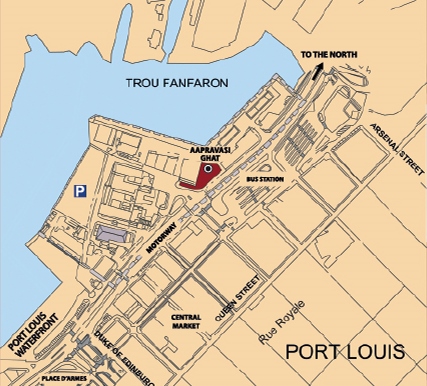Heritage Trails
Heritage trails consist of guided visits of National Monuments and heritage buildings located in the surroundings of the Aapravasi Ghat World Heritage Site. The heritage trails provide an overview of key moments in Mauritian History
Heritage trails are available on request and booking on 217 7770. The guided visit is for groups of maximum 20 people.
- Aapravasi Ghat World Heritage Site
- The Parc-à-Boulets
- Immigration Square
- Rice Store / STC Building / Proposed Site for the Galerie d’Art National
- Military Hospital
- Civil Hospital
- General Post Office
- Windmill
- Granary
- Customs area
- Central Market

Aapravasi Ghat World Heritage Site (1849-1920s)
The Aapravasi Ghat is the symbol of the Great Experiment that led to the establishment of the indentured labour system.
The Parc-à-Boulets
The Parc-à-Boulets is located in the Buffer Zone 1 of the Aapravasi Ghat World Heritage Property. In 1781, it was known as ‘Les Forges’ where a workshop was set up: ‘un atelier pour la préparation de la galgate et sarangous et pour la préparation de la plante contre les piqures des vers’. By 1791, it was renamed Parc à Boulets. According to archival sources, in 1830, a Convict Barrack was built for Indian convicts at Parc-à-Boulets which was operational until 1870 when the barrack was partially destroyed.
Immigration Square
On the other side of the Aapravasi Ghat World Heritage Site, today stands the Northern Bus Terminal. More than 170 years ago, this area formed part of the Immigration Depot and was the Old Immigrants Yard for those returning to India and elsewhere in the Indian Ocean World. Nowadays, it is commonly known as Place de l’Immigration or Immigration Square. During the 19th and 20th centuries, the whole area thrived and bustled with commercial activities and was one of the socio-economic centres of the town of Port Louis. It was one of the most cosmopolitan areas of the colony’s capital where numerous Chinese, Indian, and European shops were located and from which owners of sugar plantations bought rations for indentured labourers. In this invigorating and vibrant atmosphere, people of different origins interacted daily through traditional business transactions and socialization must the same as today.
Rice Store / STC Building / Proposed Site for the Galerie d’Art National
Situated next to Aapravasi Ghat World Heritage Property, the rice store was used temporarily to receive indentured labourers in 1844 before the immigration depot (Aapravasi Ghat) was constructed.
Military Hospital Complex (1740)
The Military Hospital was constructed under the Governance of Mahé de La Bourdonnais. He was the first French Governor that permanently resided on the island. He initiated a number of civil and infrastructural works on the island that were crucial to succeed in such development. The Military Hospital was one of the first buildings constructed as part of this colonial design.
Civil Hospital (1854)
The Civil Hospital was constructed in 1854 where the French prison for slaves called the “Bagne” was located. The Civil Hospital became an integral part of the health system established by the British with the aim to improve health conditions and reduce epidemics on the island.
General Post Office (1870)
The General Post Office was built with the objective to centralize the Mauritian postal system. Located on the port, the GPO received foreign correspondence via the first telegraph established in Mauritius and foreign mail arriving on boats from different parts of the world. It has served as the country’s main post office for more than 130 years.
Windmill
During the first six years of his administration, through the use of slave labour as well as contractual workers, the French governor was able to build a windmill, a bakery, workshops, fortifications, storage facilities, and a large hospital. The objective of Labourdonnais was to provide the colonists with certain modern amenities in order to improve their lives. In 1831, the windmill was restructured by Captain Llyod who was Surveyor-General, and by 1841, it was converted into an Observatory and Signal Tower.
Granary (1933)
By the early 20th century, the local British authorities had the concern to improve the imports and exports facilities on Port Louis harbour. The ‘Granary’ building was constructed to keep the imported goods, mainly grains, secure from rats carrying diseases and facilitate their dispatch on the island. The Granary covers an area of more than two acres. It is the largest storehouse ever built in the history of Port Louis and is the largest red brick structure in Mauritius. Its architecture was modeled on storage facilities existing in British ports such as in Liverpool.
Customs area (new heading to be created and description to be added below)
Built between 1831and 1832, and expanded in the late 19th Century, His Majesty’s Customs House was a complex of 3 acres which comprised of the Customs Quay, the Customs House, a large shed and area for carts, all of which were enclosed by a stone wall. It was a key point of the country’s economy, having served as customs for visitors and free immigrants during much of the 19th Century. From the years 1826 to 1843, it was only through the Customs House that indentured labourers were granted access to Mauritius. Destroyed in 1987, only its entrance gateway has survived, having been moved stone by stone to its actual location and been made into a memorial.
Central Market
Recognisable by it most famous architectural marks: three arched stone and wrought-iron entrance gateways decorated with floral designs, the Central Market or “Bazaar” has retained its use as one of the largest and most important markets in Mauritius. Inaugurated by Governor Gomm in 1844, it is the oldest market of Mauritius. Its first traders fared mainly from Madras, Pondicherry and Tranquebar to sell their goods in the colony. Nowadays it still exudes a feeling of authenticity, with merchants still selling meat, spices, vegetables, medicinal plants, herbs and goods required for religious rites in its premises, surrounded by grandiose stone walls and tall ironworks.
